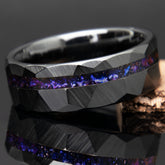Why We Use Lab Created Opal In Our Rings

Opal is a mesmerizing gemstone with its unique display of iridescence that captures the essence of nature. Opal is composed of hydrated silica and is formed by the slow deposition of silica gel in cracks and cavities of rock, and it can take millions of years to form. Due to its rarity, opals are often treasured and valued for their beauty and uniqueness.
However, with advancements in technology, lab-grown opals have emerged as an alternative to natural opals. Lab-grown opals are made using the same chemical composition as natural opals but are grown in a laboratory under controlled conditions, often taking a much shorter time to grow.
Here are some of the reasons we use lab-grown opal in our opal rings:
Color choices and control
One of the main benefits of lab-grown opal colors is their consistency and predictability. Since lab-grown opals are created under controlled conditions, they tend to have a more uniform pattern of colors. This can be beneficial for those who are looking for a specific color or want a more coordinated look in their opal rings. Additionally, lab-grown opals can be created in a variety of colors, including shades that may be rare or difficult to find in natural opals. This versatility can be appealing buyers who are looking for unique and customized pieces.
Durability
Another benefit of lab-grown opals is their durability compared to natural opals. Natural opals are relatively soft and can be prone to cracking or breaking if exposed to extreme temperatures or rapid changes in temperature. In contrast, lab-grown opals are created in a controlled environment, which can make them more durable and less prone to damage. This durability can be especially important for jewelry that will be worn frequently or for those who lead an active lifestyle. Additionally, since lab-grown opals are less likely to be damaged, they can maintain their beauty and shine for longer periods of time, making them a more practical and long-lasting option for jewelry pieces.
Sustainability
The mining of natural opals can have negative environmental impacts, including habitat destruction, water pollution, and carbon emissions. In contrast, lab-grown opals are created in a controlled environment, which can reduce the environmental impact of gemstone production. Additionally, lab-grown opals require fewer resources and energy to produce than natural opals, which can further reduce their environmental footprint. For those who prioritize sustainable and ethical sourcing of gemstones, lab-grown opals can be a more environmentally responsible option.
Conclusion
In conclusion, lab-grown opals offer several benefits over natural opals. These benefits include the consistency and predictability of their colors, their durability, and their sustainability. Lab-grown opals can be created in a variety of colors, making them a versatile and customizable option for jewelry. Their durability and resistance to damage can make them a more practical and long-lasting choice, while their sustainability can appeal to those who prioritize eco-friendliness and ethical sourcing of gemstones. While natural opals certainly have their own unique charm and beauty, lab-grown opals offer a range of benefits that make them a compelling alternative for those who want to enjoy the beauty of opals in a more practical and sustainable way.
Check out our collection of opal rings







